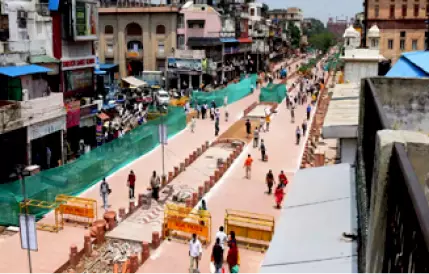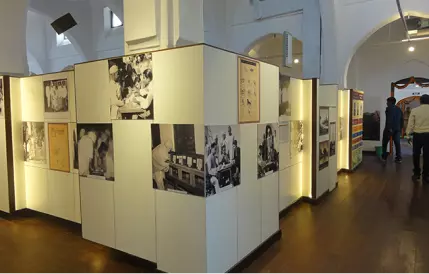quick facts
- Location: Old Delhi, India
- Built By: Mughal Emperor Shah Jahan
- Built in the Year: 1648
- Architectural style: Mughal, Indo-Islamic
- Timings: 7 am-6 pm, Tuesday-Sunday (Monday closed)
- Sound & Light Shows: 6pm onwards in English and Hindi
- Entry Fee: Rs10 for nationals, and SAARC & BIMSTEC citizens, Rs250 for other foreigners
About
The extravagant and grand Red Fort, located in Old Delhi, is one of the most significant historic structures in India that is visited and admired by thousands of visitors every day. Honored with the status of UNESCO World Heritage Site, the magnificent Lal Quila took over 8 years to stand to its present grandeur and was built by the Mughal emperor Shah Jahan as his royal residential palace.
Beaming with the state-of-the-art Mughal architecture, Lal Quila or Red Fort derives its name from the red-sandstone walls which gives it aninvincible look while also displaying the fine specimen of the Mughal architecture. Also considered as the pinnacle of the Mughal creativity, the Red Fort is of utmost significance for the people of India as the Indian Prime Minister delivers his Independence Day speech on 15th August every year from the Red Fort and it also serves as a symbolic historical monument of the rich past of the Indian subcontinent. Formerly known as Quila-e-Mubarak or the Blessed Fort, the Red Fort or Lal Quila lies on the banks of River Yamuna and at present is home to numerous museums that houses a precious collection of artifacts on display. The entire fort displays the ingenious brilliance of the Mughal architecture which is also the inspiration behind several other monuments in different cities of North India. Though, much of the fort and its splendor is now faded or have been destroyed, the Archaeological Survey of India is responsible for its security and for the preservation of this imperial heritage and historical opulence.
About
The extravagant and grand Red Fort, located in Old Delhi, is one of the most significant historic structures in India that is visited and admired by thousands of visitors every day. Honored with the status of UNESCO World Heritage Site, the magnificent Lal Quila took over 8 years to stand to its present grandeur and was built by the Mughal emperor Shah Jahan as his royal residential palace.
Beaming with the state-of-the-art Mughal architecture, Lal Quila or Red Fort derives its name from the red-sandstone walls which gives it aninvincible look while also displaying the fine specimen of the Mughal architecture. Also considered as the pinnacle of the Mughal creativity, the Red Fort is of utmost significance for the people of India as the Indian Prime Minister delivers his Independence Day speech on 15th August every year from the Red Fort and it also serves as a symbolic historical monument of the rich past of the Indian subcontinent. Formerly known as Quila-e-Mubarak or the Blessed Fort, the Red Fort or Lal Quila lies on the banks of River Yamuna and at present is home to numerous museums that houses a precious collection of artifacts on display. The entire fort displays the ingenious brilliance of the Mughal architecture which is also the inspiration behind several other monuments in different cities of North India. Though, much of the fort and its splendor is now faded or have been destroyed, the Archaeological Survey of India is responsible for its security and for the preservation of this imperial heritage and historical opulence.
About
The extravagant and grand Red Fort, located in Old Delhi, is one of the most significant historic structures in India that is visited and admired by thousands of visitors every day. Honored with the status of UNESCO World Heritage Site, the magnificent Lal Quila took over 8 years to stand to its present grandeur and was built by the Mughal emperor Shah Jahan as his royal residential palace.
Beaming with the state-of-the-art Mughal architecture, Lal Quila or Red Fort derives its name from the red-sandstone walls which gives it aninvincible look while also displaying the fine specimen of the Mughal architecture. Also considered as the pinnacle of the Mughal creativity, the Red Fort is of utmost significance for the people of India as the Indian Prime Minister delivers his Independence Day speech on 15th August every year from the Red Fort and it also serves as a symbolic historical monument of the rich past of the Indian subcontinent. Formerly known as Quila-e-Mubarak or the Blessed Fort, the Red Fort or Lal Quila lies on the banks of River Yamuna and at present is home to numerous museums that houses a precious collection of artifacts on display. The entire fort displays the ingenious brilliance of the Mughal architecture which is also the inspiration behind several other monuments in different cities of North India. Though, much of the fort and its splendor is now faded or have been destroyed, the Archaeological Survey of India is responsible for its security and for the preservation of this imperial heritage and historical opulence.
About
The extravagant and grand Red Fort, located in Old Delhi, is one of the most significant historic structures in India that is visited and admired by thousands of visitors every day. Honored with the status of UNESCO World Heritage Site, the magnificent Lal Quila took over 8 years to stand to its present grandeur and was built by the Mughal emperor Shah Jahan as his royal residential palace.
Beaming with the state-of-the-art Mughal architecture, Lal Quila or Red Fort derives its name from the red-sandstone walls which gives it aninvincible look while also displaying the fine specimen of the Mughal architecture. Also considered as the pinnacle of the Mughal creativity, the Red Fort is of utmost significance for the people of India as the Indian Prime Minister delivers his Independence Day speech on 15th August every year from the Red Fort and it also serves as a symbolic historical monument of the rich past of the Indian subcontinent. Formerly known as Quila-e-Mubarak or the Blessed Fort, the Red Fort or Lal Quila lies on the banks of River Yamuna and at present is home to numerous museums that houses a precious collection of artifacts on display. The entire fort displays the ingenious brilliance of the Mughal architecture which is also the inspiration behind several other monuments in different cities of North India. Though, much of the fort and its splendor is now faded or have been destroyed, the Archaeological Survey of India is responsible for its security and for the preservation of this imperial heritage and historical opulence.
About
The extravagant and grand Red Fort, located in Old Delhi, is one of the most significant historic structures in India that is visited and admired by thousands of visitors every day. Honored with the status of UNESCO World Heritage Site, the magnificent Lal Quila took over 8 years to stand to its present grandeur and was built by the Mughal emperor Shah Jahan as his royal residential palace.
Beaming with the state-of-the-art Mughal architecture, Lal Quila or Red Fort derives its name from the red-sandstone walls which gives it aninvincible look while also displaying the fine specimen of the Mughal architecture. Also considered as the pinnacle of the Mughal creativity, the Red Fort is of utmost significance for the people of India as the Indian Prime Minister delivers his Independence Day speech on 15th August every year from the Red Fort and it also serves as a symbolic historical monument of the rich past of the Indian subcontinent. Formerly known as Quila-e-Mubarak or the Blessed Fort, the Red Fort or Lal Quila lies on the banks of River Yamuna and at present is home to numerous museums that houses a precious collection of artifacts on display. The entire fort displays the ingenious brilliance of the Mughal architecture which is also the inspiration behind several other monuments in different cities of North India. Though, much of the fort and its splendor is now faded or have been destroyed, the Archaeological Survey of India is responsible for its security and for the preservation of this imperial heritage and historical opulence.
About
The extravagant and grand Red Fort, located in Old Delhi, is one of the most significant historic structures in India that is visited and admired by thousands of visitors every day. Honored with the status of UNESCO World Heritage Site, the magnificent Lal Quila took over 8 years to stand to its present grandeur and was built by the Mughal emperor Shah Jahan as his royal residential palace.
Beaming with the state-of-the-art Mughal architecture, Lal Quila or Red Fort derives its name from the red-sandstone walls which gives it aninvincible look while also displaying the fine specimen of the Mughal architecture. Also considered as the pinnacle of the Mughal creativity, the Red Fort is of utmost significance for the people of India as the Indian Prime Minister delivers his Independence Day speech on 15th August every year from the Red Fort and it also serves as a symbolic historical monument of the rich past of the Indian subcontinent. Formerly known as Quila-e-Mubarak or the Blessed Fort, the Red Fort or Lal Quila lies on the banks of River Yamuna and at present is home to numerous museums that houses a precious collection of artifacts on display. The entire fort displays the ingenious brilliance of the Mughal architecture which is also the inspiration behind several other monuments in different cities of North India. Though, much of the fort and its splendor is now faded or have been destroyed, the Archaeological Survey of India is responsible for its security and for the preservation of this imperial heritage and historical opulence.
History of Red Fort
When Shah Jahan, the then Mughal Emperor, decided to shift his capital city from Agra to Delhi, he commissioned the establishment of the Red Fort as his citadel of the capital city. The construction for the fort began in the year 1639 and was complete in 1648. The magnum opus housed an entire city inside it with streets bustling with people and stalls, beautiful gardens, fountains, and several small halls and sitting areas for the king and queens. According to the wishes of demand of Shah Jahan that the old fort of Salimgarh is to be contained inside, the walls of Red Fort were built asymmetrical which was unlike any other Mughal architecture.
The fort saw several Mughal emperors during its lifetime and remained the seat of the imperial Mughal rule till 1857. After the rule of the Mughal emperor Aurangzeb, another ruler Farrukhshiyar replaced the beautiful silver ceiling with copper to raise money. In 1739, the Persian emperor Nadir Shah invaded Delhi and looted the Lal Quila, also taking the Peacock throne away with him. The fort saw many attacks and plunders between 1739 and 1857 by Ahmad Shah, Marathas, Sikhs, and the British, where it ended its rule of the Mughals with the defeat of Bahadur Shah II, who along with the other residents of the fort had participated in the fight against the Britishers but got defeated in the end. The Britishers also looted a lot of precious gems and artifacts, including the invaluable Kohinoor and destroyed most of the interior of the red fort. When Lord Curzon became the viceroy of India, he instructed the refurbishment of the edifice and the gardens.

Architecture of Red Fort
Talking about the architecture, the Red Fort is spread across in 254.67 acres of land with the defensive high wall enclosing the fort standing at 2.41 kilometers. It was designed and constructed by the legendary architect Ustad Ahmad Lahauri who created this magnificence that serve as a fine example of the Islamic and Mughal architectural style while also infusing the creative style of the Tirumids and the Persians.The chief entrance of the fort is known as ‘Lahori Gate’ which opens at ‘Chatta Chowk’, a covered street that housed some of the most talented jewelers, carpet makers, weavers, and goldsmiths of Delhi. The covered passage also had ‘Meena Bazar’ which was the shopping hub for the royal ladies, while the ‘NaubatKhana’, located a few meters from the ‘Chatta Chowk’ used to be the music heaven where talented musicians would play for the emperor and for the arrival of the princesses. The fort also has other gates, the most prominent ones apart from Lahori gate are Ajmeri gate, Kashmiri gate, Mori gate, Turkman gate, and Delhi gate.
The Red Fort or Lal Quila houses inside it all the paraphernalia associated with the Mughal dynasty such as the halls for the public and private audience, domed and arched marble palaces, luxurious private apartments, a mosque (Moti Masjid), and well-manicured and richly designed gardens. The hall ‘Diwan-i-Am’ was used by the emperor to hear complaints of his subjects while ‘Diwan-i-Khas’ was used to hold private meetings. Other rooms such as the ‘Hammam’ (Royal Bath), ‘Shah Burj’ (Shah Jahan’s private working area), Pearl Mosque, and ‘Rang Mahal’ (where princesses and mistresses lived) also add on to the grandeur of the magnum opus that the Red Fort is.

Light and Sound Show
Although, the Red Fort is visited and admired by numerous travelers from across the world for its architectural grandeur and elaborate history, there is one other attraction that capture the attention of the tourists and compel them to come back again and again. The Light and Sound Show is a sight to behold which is held every evening for one hour inside the fort premises. It is a magical fest of lights and soundsthat tells the history of the fort in a very imaginative and creative way. The show is conducted both in Hindi and English at different timings –
Hindi: 7:30 pm – 8:30 pm
English: 9 pm – 10 pm
The ticket prices are Rs60 for adults and Rs20 for children on weekdays and Rs80 for adults and Rs30 for children during the weekends and government holidays.
How to Reach
The Red Fort can be reached by the nearest metro station which is in Chandni Chowk on the Yellow Line, and you will easily get a cab or auto rickshaw from the station. Public buses are also available from all parts of the city that travel regularly on this route.

The Red Fort
Commonly recognized as Lal Qila, The Red Fort in Old Delhi is another masterpiece built during the Mughal era by the Mughal Emperor Shah Jahan in the mid-17th century. Declared as the UNESCO World Heritage Site in 2007, this majestic magnum opus is a fine example of Indi-Islamic architecture and stands 75 feet tall with a whole different world inside it.




